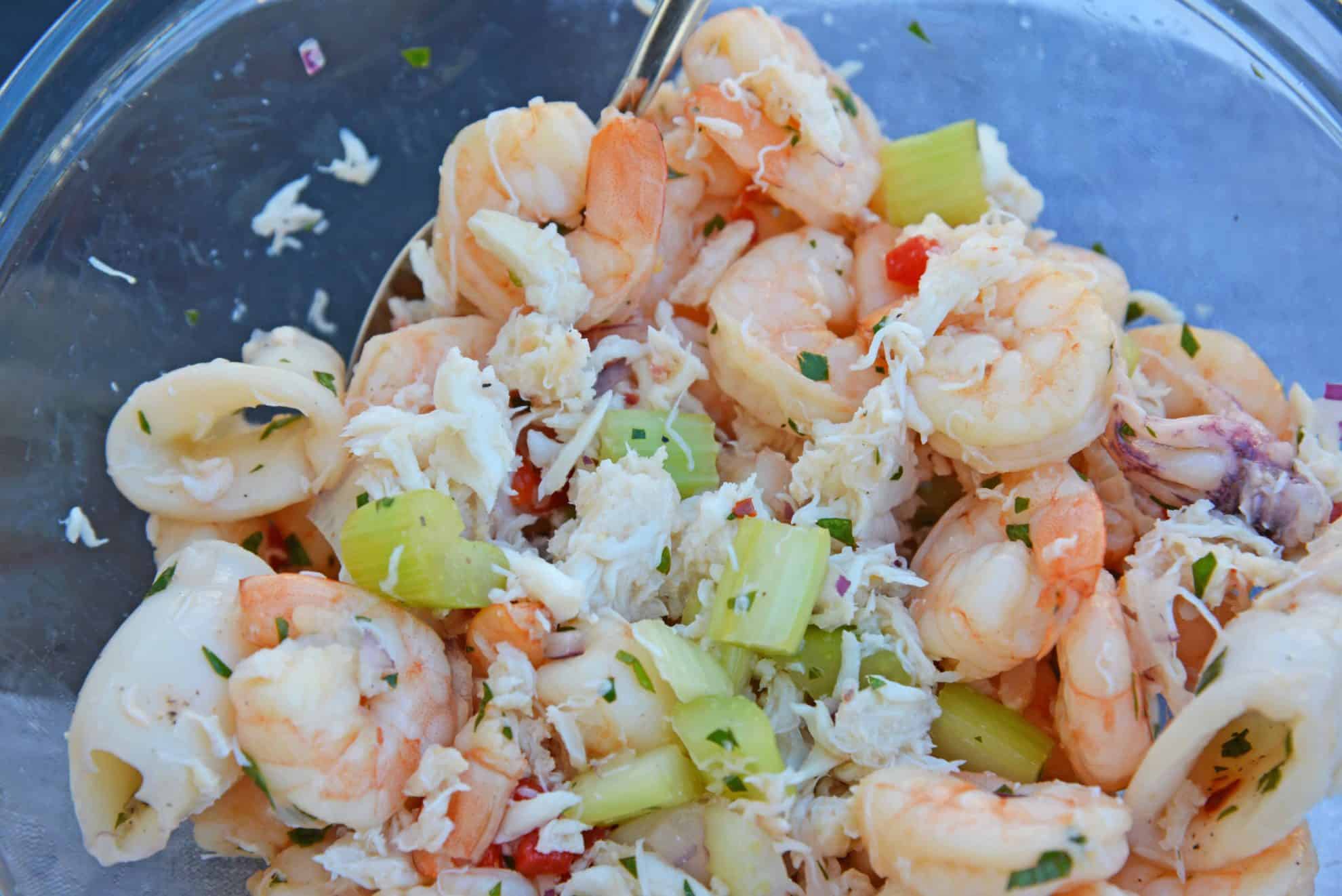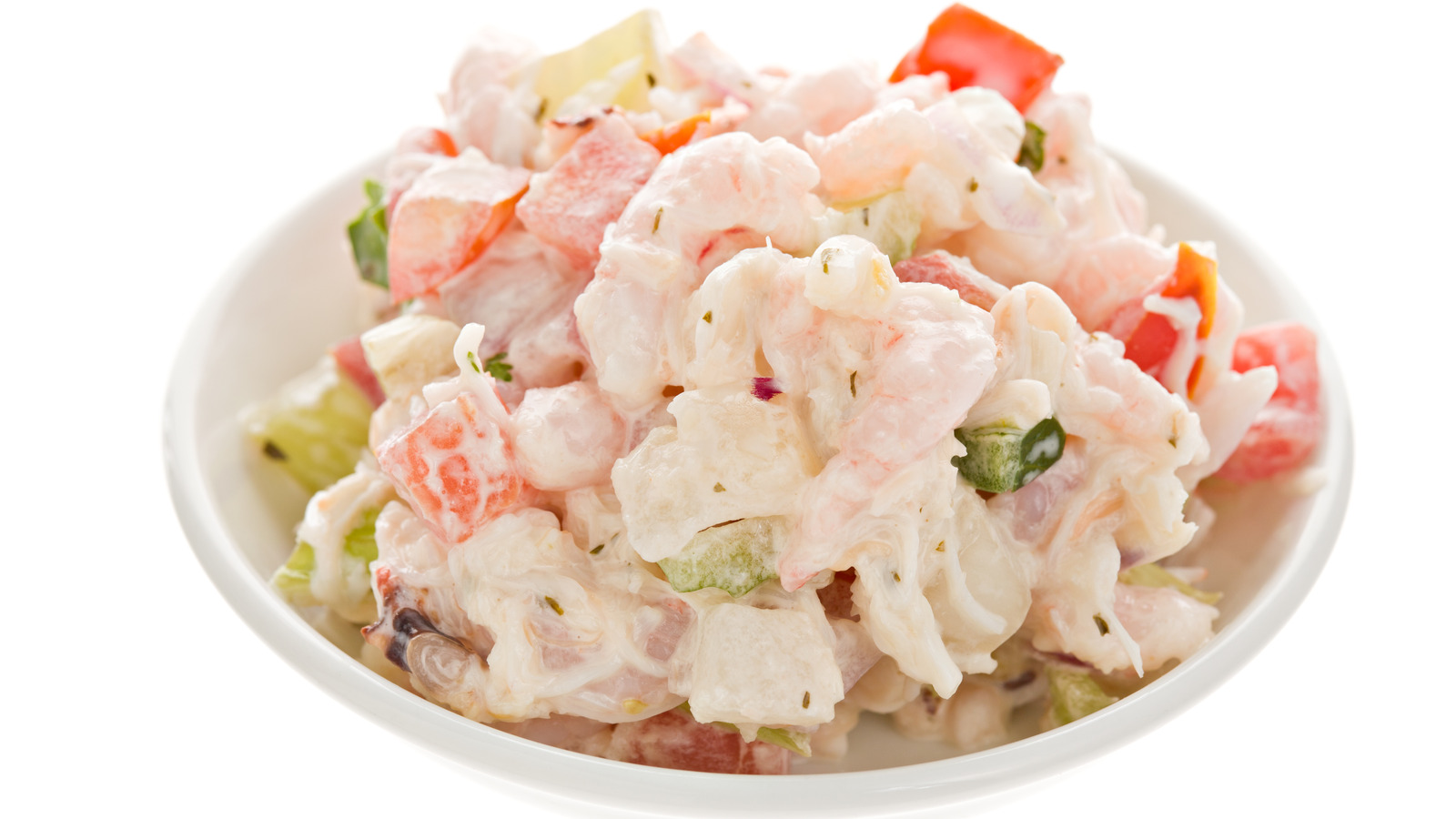Do you ever find yourself with leftover seafood salad and wonder what to do with it? You’re not alone.
Many people face the dilemma of whether they can freeze seafood salad to enjoy later. This question might seem straightforward, but the answer can surprise you. Imagine savoring the fresh taste of your favorite seafood salad days after you first prepared it.
Freezing could be your secret weapon. But here’s the catch: freezing seafood salad isn’t as simple as tossing it in the freezer. There are crucial steps you need to follow to ensure its taste and texture stay intact. Keep reading to discover the secrets of preserving your seafood salad like a pro. Your taste buds will thank you.
Benefits Of Freezing Seafood Salad
Preserving seafood salad by freezing can extend its freshness and flavor. It’s a convenient way to save leftovers for later enjoyment. Properly stored, frozen seafood salad maintains its quality, ensuring a tasty meal ready whenever needed.
Freezing seafood salad might not be the first thing that comes to mind when you think about preserving it, but it actually offers several benefits. Imagine having a delicious seafood salad ready to enjoy without the fuss of preparation. Whether you’re a busy parent or someone who loves quick meals, freezing seafood salad can be a game-changer. Let’s delve into the benefits of this convenient kitchen hack.
Preservation Of Freshness
Freezing seafood salad allows you to preserve its freshness for longer periods. This is particularly useful if you’ve prepared a large batch and can’t consume it all in one go. By freezing, you lock in the flavors and nutrients, ensuring your salad tastes just as good when you defrost it. This means less food waste, and more enjoyment from your efforts in the kitchen.
Convenience And Time-saving
Imagine coming home after a long day and having a ready-to-eat seafood salad waiting for you in the freezer. The convenience of pulling out a portion and letting it thaw while you unwind is unbeatable. It saves you the time you’d otherwise spend chopping and mixing ingredients. This can be particularly helpful during busy weekdays when cooking feels like a chore.
Cost-effective Meal Planning
Freezing seafood salad can be a smart way to stretch your grocery budget. When seafood is on sale, buy in bulk and prepare a large batch of salad. Freeze portions for later use, and you’ll have multiple meals from one shopping trip. This approach not only saves money but also ensures you always have a healthy option available.
Versatility In Serving Options
Having frozen seafood salad on hand gives you versatility in serving options. You can use it as a side dish, a main course, or even as a filling for wraps and sandwiches. It allows you to experiment with different meal combinations without the hassle of preparing the base each time. Your creativity in the kitchen can flourish with this simple solution.
Enhanced Flavor Development
Did you know that freezing can sometimes enhance the flavor of seafood salad? As it freezes and thaws, the ingredients have more time to meld together, resulting in a more flavorful dish. Think of it as a marinating process that continues even in the freezer. This can make your seafood salad even more delicious when you’re ready to enjoy it. Have you ever tried freezing seafood salad? What was your experience like? If you haven’t, would you consider giving it a try after learning about these benefits?
Types Of Seafood In Salad
Seafood salads are a delightful blend of flavors and textures. They often feature a variety of seafood types. Each adds its own unique taste and nutritional benefits. Understanding these types can enhance your salad experience.
Shellfish Varieties
Shellfish bring a rich, savory flavor to seafood salads. Shrimp is a popular choice. It’s tender and slightly sweet. Crab offers a delicate, flaky texture. It pairs well with creamy dressings. Lobster adds a touch of luxury. Its firm, juicy meat is often a highlight.
Fish Options
Fish adds a hearty element to salads. Salmon is a top pick. It’s rich in flavor and omega-3s. Tuna offers a mild taste. It’s versatile and blends well with many ingredients. Cod is another option. It’s light and flaky, perfect for delicate salads.
Other Ingredients
Beyond seafood, salads often include fresh vegetables. Crisp lettuce provides a refreshing crunch. Tomatoes add sweetness and acidity. Avocado offers creaminess and healthy fats. Herbs like dill and parsley bring freshness. These ingredients complement the seafood, creating a balanced dish.
Proper Freezing Techniques
Freezing seafood salad can be tricky due to its ingredients. Mayonnaise-based dressings separate when frozen, altering texture. Opt for freezing the seafood separately, then mix fresh salad ingredients before serving for best results.
Properly freezing seafood salad preserves its taste and texture. Follow these steps for best results. The method ensures your dish stays fresh and delicious after thawing.
Preparation Steps
Seafood salad must be fresh before freezing. Check each ingredient. Remove any that seem spoiled. Rinse and drain seafood thoroughly. Pat dry to remove excess moisture. Mix with salad dressing if desired. This helps seal flavors during freezing.
Packaging Methods
Use airtight containers or heavy-duty freezer bags. Remove air from bags to prevent freezer burn. Label containers with the date to track freshness. Consider portioning salad into smaller servings. This makes thawing easier.
Freezing Duration
Seafood salad stays fresh in the freezer for up to three months. Mark your calendar to track time. Regularly check the freezer temperature. It should be set at 0°F (-18°C) or lower. This ensures optimal preservation.

Credit: www.savoryexperiments.com
Thawing And Serving Suggestions
Thawing seafood salad properly ensures safety and flavor retention. Serve it just right for a delightful culinary experience. Discover the best methods to thaw and serve your seafood salad for optimal taste and texture. This guide provides practical tips to help you enjoy your dish with ease and confidence.
Safe Thawing Methods
Thaw seafood salad in the refrigerator overnight. This method is the safest. Keep the salad in its container. Place it on a plate to catch any drips. Never thaw seafood salad at room temperature. This prevents bacteria growth. If you need it faster, use cold water. Seal the salad tightly in a plastic bag. Submerge it in cold water for a few hours. Change the water every 30 minutes.
Serving Ideas
Serve seafood salad chilled for the best taste. Enhance its flavors with lemon juice. Add fresh herbs like dill or parsley. Pair it with crispy crackers or toasted bread. Serve it over a bed of fresh greens. Use it as a filling for sandwiches. Try it in a wrap with sliced vegetables. For a creative touch, stuff it in avocado halves. These ideas make your meal enjoyable and satisfying.
Common Mistakes To Avoid
Freezing seafood salad can lead to texture changes, making it mushy. Mayonnaise-based dressings separate upon thawing, affecting taste. Always store seafood salad in airtight containers to maintain freshness and prevent contamination.
Freezing seafood salad can be tricky, but it’s a great way to preserve your meal if done correctly. However, some common mistakes can lead to loss of flavor or texture. Let’s dive into these pitfalls so you can freeze your seafood salad with confidence.
1. Not Considering Ingredients
Seafood salad often contains a mix of ingredients like mayonnaise, vegetables, and seafood. Not all of these freeze well. Mayonnaise can separate, leaving your salad watery and unappetizing. Vegetables might lose their crunch, leaving you with a mushy texture. It’s crucial to think about how each ingredient will react to freezing.
2. Freezing In Large Batches
It’s tempting to freeze your salad in one big container. But this can lead to uneven thawing, with some parts still frozen while others are defrosted. Consider dividing your salad into smaller portions. This not only speeds up thawing but also allows you to enjoy it in manageable servings.
3. Neglecting Proper Storage Techniques
Improper storage can ruin your seafood salad. Use airtight containers or resealable freezer bags to prevent freezer burn. Remove as much air as possible to keep your salad fresh. Label your containers with the date, so you know when it’s best to consume.
4. Forgetting To Adjust Seasoning
Freezing can dull the flavors of your seafood salad. You might find it less tasty once thawed. Before freezing, consider adding a little extra seasoning. This can help maintain the salad’s flavor profile, ensuring it tastes just as good after freezing.
5. Skipping The Thawing Process
Thawing is often overlooked but crucial. Avoid defrosting your salad at room temperature, as this can lead to bacterial growth. Instead, thaw it slowly in the refrigerator. This ensures your salad remains safe to eat and retains its taste and texture. Have you ever frozen seafood salad only to find it disappointing? By avoiding these common mistakes, you can ensure your seafood salad remains delicious and ready whenever you are. Keep these tips in mind, and you’ll master the art of freezing seafood salad like a pro.

Credit: www.thedailymeal.com
Expert Tips For Best Results
Freezing seafood salad requires careful preparation to maintain taste and texture. Always use fresh ingredients before freezing. Store in airtight containers to avoid freezer burn and preserve flavor.
When it comes to preserving the delightful taste and texture of your seafood salad, freezing can be a game changer. However, not every seafood salad is created equal in the freezer. With a few expert tips, you can ensure your salad retains its quality and flavor. Let’s dive into how you can freeze your seafood salad with the best results.
Maintaining Texture
Texture is key in seafood salad, and freezing can sometimes alter it. To keep your salad from becoming mushy, consider the ingredients. Mayonnaise-based dressings tend to separate when frozen, so think about using a vinegar-based dressing instead.
Before freezing, pat dry any excess moisture from seafood and vegetables. This helps prevent ice crystals from forming. You might also try freezing the seafood separately from the salad base, then mixing them once thawed.
Enhancing Flavor
Flavor can sometimes diminish in the freezing process. To counter this, slightly over-season your salad before freezing. The flavors will mellow out when you defrost the salad, leaving it perfectly balanced. Consider adding fresh herbs and spices after thawing to refresh the taste. A squeeze of lemon juice can also brighten the flavors.
Have you ever tried using flavored oils? They can add a burst of taste when mixed into your thawed salad. Taking these steps ensures that your seafood salad remains a delicious treat, even after spending time in the freezer. What methods have you tried to maintain the quality of your frozen dishes? Share your thoughts in the comments!
Alternative Preservation Methods
Seafood salad is a delicious dish that many enjoy. Yet, preserving it can be tricky. Freezing is one option, but there are other methods too. These alternatives help maintain freshness and flavor. Let’s explore some effective ways to preserve your seafood salad.
Refrigeration Tips
Refrigeration is a common method for preserving seafood salad. Store it in an airtight container to prevent odors. Place it on a shelf, not in the door, for consistent cooling. Consume refrigerated seafood salad within two days. This ensures it stays fresh and tasty.
Using Preservatives
Preservatives can extend the life of seafood salad. Lemon juice is a natural option. It helps in keeping the seafood fresh. Vinegar is another good choice. It adds flavor and acts as a preservative. Always use preservatives in moderation. This keeps the salad safe and enjoyable.
:max_bytes(150000):strip_icc()/AR-232287-Mels-Crab-Salad-ddmfs-beauty-4x3-509140e1bd0d449690bec3280424db34.jpg)
Credit: www.allrecipes.com
Frequently Asked Questions
Can Fresh Seafood Salad Be Frozen?
Fresh seafood salad should not be frozen. Freezing affects texture and flavor negatively. It is best enjoyed fresh. Use airtight containers for short-term storage in the fridge. Consume within 2-3 days to maintain freshness and taste. Consider making smaller portions to avoid waste.
How Long Does Seafood Salad Last In The Refrigerator?
Seafood salad lasts 3-4 days in the refrigerator if stored in an airtight container. Always check for spoilage signs before consuming. Keep it chilled below 40°F (4°C) for optimal freshness. Discard if it smells off or the texture changes.
Can You Freeze Crab Salad With Mayonnaise?
Freezing crab salad with mayonnaise is not recommended. Mayonnaise can separate, altering the salad’s texture and taste. It’s best to prepare fresh crab salad for optimal flavor and quality. If needed, freeze crab meat separately and mix with mayonnaise after thawing.
What Seafood Can You Not Freeze?
Do not freeze shellfish like oysters, clams, and mussels. They lose texture and flavor when frozen. Sushi-grade fish is best consumed fresh for optimal taste and quality. Freezing can compromise their delicate nature. Always check seafood guidelines for best storage practices.
Final Words
Freezing seafood salad is possible, but with caution. Always consider texture and taste. Fresh ingredients matter a lot. Use airtight containers to prevent freezer burn. Thaw slowly in the fridge for best results. Seafood salad can change slightly after freezing.
Not all salads will taste the same. So, test small portions first. This helps avoid disappointment. Enjoy your seafood salad fresh or well-prepared from the freezer. Proper techniques ensure delicious outcomes. Keep experimenting with different salad types. Taste and quality can vary.
Adjust methods for better results. Enjoy your culinary adventures!

Leave a Reply